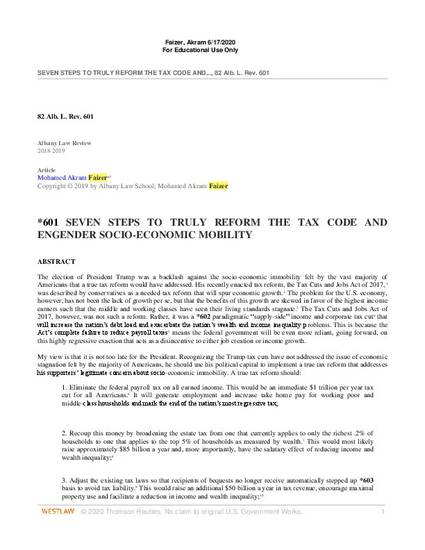
Article
SEVEN STEPS TO TRULY REFORM THE TAX CODE AND ENGENDER SOCIO-ECONOMIC MOBILITY.doc
Albany Law Review
(2018)
Abstract
The election of President Trump was a backlash against the socio-economic immobility felt by the vast majority of Americans that a true tax reform would have addressed. His recently enacted tax reform, the Tax Cuts and Jobs Act of 2017, was described by conservatives as a needed tax reform that will spur economic growth. The problem for the U.S. economy, however, has not been the lack of growth per se, but that the benefits of this growth are skewed in favor of the highest income earners such that the middle and working classes have seen their living standards stagnate. The Tax Cuts and Jobs Act of 2017, however, was not such a reform. Rather, it was a paradigmatic “supply-side” income and corporate tax cut4 that will increase the nation’s debt load and exacerbate the nation’s wealth and income inequality problems. This is because the Act’s complete failure to reduce payroll taxes means the federal government will be even more reliant, going forward, on this highly regressive exaction that acts as a disincentive to either job creation or income growth.
My view is that it is not too late for the President. Recognizing the Trump tax cuts have not addressed the issue of economic stagnation felt by the majority of Americans, he should use his political capital to implement a true tax reform that addresses his supporters’ legitimate concern about socio-economic immobility. A true tax reform should:
1. Eliminate the federal payroll tax on all earned income. This would be an immediate $1 trillion per year tax cut for all Americans. It will generate employment and increase take home pay for working poor and middle-class households and mark the end of the nation’s most regressive tax;
2. Recoup this money by broadening the estate tax from one that currently applies to only the richest .2% of households to one that applies to the top 5% of households as measured by wealth. This would most likely raise approximately $85 billion a year and, more importantly, have the salutary effect of reducing income and wealth inequality;
3. Adjust the existing tax laws so that recipients of bequests no longer receive automatically stepped up basis to avoid tax liability. This would raise an additional $50 billion a year in tax revenue, encourage maximal property use and facilitate a reduction in income and wealth inequality;
4. Implement a $1 per gallon gas tax on all petroleum sales nationwide. This will generate $100 billion per year, engender more efficient energy usage, and incentivize liberalization and democratization in oil exporting countries;
5. End the mortgage interest tax deduction, which will progressively generate $71 billion in annual revenue and encourage fiscal responsibility in home buying;
6. Introduce an 8% nationwide sales tax that will generate approximately $620 billion a year in trust fund revenue and encourage savings and fiscal responsibility by households nationwide; and
7. Implement a trigger feature to the tax reform such that if the revenue generated by the proposed taxes and tax expenditure eliminations outlined above is insufficient to fund the nation’s entitlement programs, they are to be automatically readjusted upward for the following year to ensure the entitlement trust funds remain budget neutral. If the tax reform generates excess revenue, the trigger will insure the tax take is readjusted downward the following year. The advantage of the trigger is that it will account for the public’s distrust in the national government by ensuring that revenues generated from the new taxes are spent only on entitlement programs.
Keywords
- Tax Law,
- Socio-Economomic Mobility,
- Constitutional Law,
- Fiscal Policy
Disciplines
Publication Date
Winter December, 2018
DOI
Winter 2018
Citation Information
82 Alb. L. Rev. 601 (2018/19)
Creative Commons license

This work is licensed under a Creative Commons CC_BY International License.
